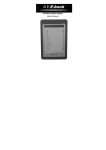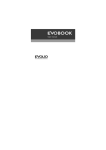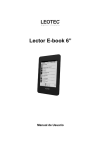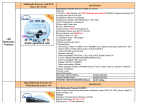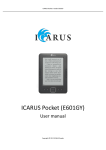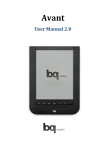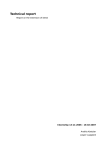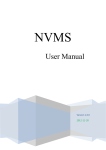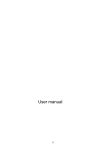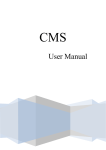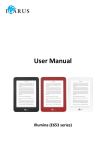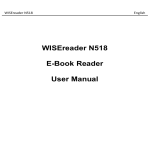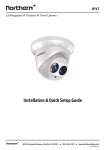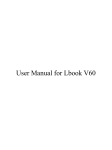Download Kogan eBook Reader
Transcript
KGN<ϲs USER MANUAL Chapter 1 Product Specifications Chapter 2 Button Instructions Chapter 3 Menu Introduction Chapter 4 eBook Library Chapter 5 Music Player Chapter 6 Picture Explorer Chapter 7 My Bookmarks Chapter 8 My Favourites Chapter 9 Recent Chapter 10 File Explorer Chapter 11 Settings Chapter 12 Inputting Chapter 13 Charging Chapter 14 USB connection Chapter 15 Importing DRM Contents Chapter 1 Product Specifica ons ● Display: 6” Electronic Paper Display ● Resolu on: 600x800 pixels (16 bit Greyscale) ● Processor: Samsung S3C2416 ● DDR2 : 64 MB ● Ba ery: 1700mAh/3.7V Li-Polymer Ba ery ● Adapter: DC5V 800mA ● Supported Text Formats: PDF, CHM, EPUB, TXT, HTM, HTML, RTF, PDB, DJVU, DJV, iw44, iw4, FB2, OEB, PRC, MOBI, TCR, OPF ● Supported Audio Formats: MP3 (32kbps-384kbps) ● Supported Image Formats: JPEG, PNG, TIF, GIF, BMP ● Expandable Memory: SD Card/ MMC ● Supported Languages: English, Russian, Spanish, Dutch, French, German, Italian, Portuguese ● Dimensions: 178(L) x 128.4 (W) x 9.9(H) mm ● Weight: 228g Chapter 2 Introduction to parts of the eBook FRONT REAR 1–Direct Access Buttons 5–Power Button To select items on the screen 6–SD card slot 2–Page Turning But tons 7–Reset Button 3– 3.5 mm Headphone Jack To reset the eBook reader, use a pen or 4–USB connector other sharp- pped object to depress To connect to the USB charger or PC the bu on Chapter 3 Menu Introduction 1 – Books This allows you to access books loaded on the eBook reader 2 – Music This application lets you access and play audio files stored on the eBook reader 3 – Photos This application lets you view photos loaded onto the eBook reader 4 – Bookmarks This will display the saved bookmarks 5 – Favourites This will display the list of favourites 6 – Recent Recent items read or used by the user will be shown. 7 – File explorer 8 – Settings 9 – User Manual Chapter 4 eBook Library 1. Press the corresponding button of the category you wish to choose 2. Operate the 3. Press menu button buttons to turn pages once submenu function appears 3.1 - Favourites Add books to your list of favourites. This allows books marked as ‘favourites’ to be easily accessible 3.2 - Go to Page Go directly to a desired page, by inputting the page number. 3.3 - Search Find a book stored on the eBook reader by inpu ng a word or phrase from its tle 3.4 – Music Go to music playback interface to access and control the music available on the eBook reader 3.5 – Return Closes the drop down menu and returns to the book’s menu 4. Choose a book to read 4.1 Press to turn the page 5. Press the menu button once submenu function appears when reading an eBook 5.1 Refresh The screen will be refreshed 5.2 Bookmark view Displays bookmarks 5.3 Bookmark add Press to add a bookmark for the current page. 5.4 Music Press to go to the music player 5.5 Settings Mark: if there is text passing the edges in PDF mode 5.5.1 Font Select different Fonts: Microsoft Yahei, Arial, Courier, Times, ARIALN 5.5.2 Encode If the encoding is incorrect 5.5.3 Margins To set the margins 5.5.4 Line spacing To set line spacing 5.5.5 Hyphenation To make adjustments for sentence structure 5.5.6 Bold To display text in bold 5.5.7 Italic To display text in italic 5.5.8 Book information Press to see information on the eBook currently opened * Please note that features 5.5.1, 5.5.3 & 5.5.7 are not compatible with ePub or PDF files. 5.6 Directory view Press “Directory view” to go into this book’s directory, and select favourite directory to read directly 5.7 Search The search contents will be displayed. Press the corresponding bu on of to look up the previous or next key words 5.8 Page Jump Allows you to move to the desired page by entering the page number 5.9 Rotate the text 90° 5.10 Zoom To zoom in or zoom out 5.11 Return Press to close the drop down menu and return to the Books menu Chapter 5 Selecting from music list 1. From the Main Menu, select “Music” to browse the Playlist stored on the eBook reader 2. Press to turn the page in playlist. Press menu button to go to the menu function: 2.1 Favourites Press “favourites”, the spot on the right side of playlist is empty. Operate the corresponding button to choose the music you like, the spot will become solid. After confirming, the music is added into “favourites”. Enter “favourites” under the main menu; you can listen to the saved music 2.2 Go to Page Press “go to page” and enter the page you want to go and confirm. The playlist will skip to the page. 2.3 Search Press “search” and enter the key words of the music you want, then press search. 2.4 Return Press “Return” to return from sub-menu. 3 Operate the button of corresponding music to play music. Operate the menu to adjust the music. 3.1 To skip to the next track or return to the previous track, press on the “ ” button, press” 3.2 Press “volume up” ” to the sub-menu. /”volume down” to adjust the volume. 3.3 Press “mute” to enter mute mode, press again to resume the volume. 3.4 Press on the button “play mode” to change the music play mode. There are 3 modes: Random , Loop and Repeat Once . 3.5 Press “play/pause” to play or pause current audio playback. 3.6 Press “stop” to stop the current playing music. 3.7 Press “Return” to return back to the Music list. Remarks: 1. The eBook reader only supports MP3 audio files. 2. The eBook reader allows you to listen to your favourite MP3s while you are reading. Chapter 6 Photo Explorer 1. Press the corresponding button to enter “photo explorer”, displaying all the picture list of different formats. Press “ ” to show sub-menu: 1.1 Favourites Press “favourites”, the round dot on the right side of the photo list is empty. After pressing the corresponding button to choose the favourite picture, the round dot becomes solid. And then press the corresponding button to add the picture into “favourites”. You can find your favourite pictures by entering “Favourites” under the main menu. 1.2 Go to Page Go directly to the desired page by inputting the page number. 1.3 Search Find a photo stored in the eBook; by inputting a word from its title. 1.4 Thumbnails View Photos in Thumbnails. 1.5 Music Go to music playback interface to access and control the music available on the E-book. 1.6 Return Close the drop-down menu and return to the Photo Explorer. 1. Photo view Press the corresponding access button to view the pictures. 2.1 Press “ ”to rotate the pictures 1.2 Press “ “ to zoom in /out. A er zoom in/out, press the corresponding bu on to move the picture up and down, le and right. 1.3 Moving direc on key Press to move the picture up. Press to move the picture right. Press to move the picture le . Press to move the picture down . 2.4 Return Press to return to the last interface. Chapter 7 My Bookmarks Press “ ” to show sub-menu 7.1 Delete 7.2 Go to page many bookmarks in your e-book read. 7.3 Search from it’s filename. 7.4 Music Go to music playback interface to access and control the music available on the E-book. 7.5 Return Close the drop down menu and return to the previous interface Chapter 8 My Favourites 1. When reading, listening or browsing pictures, you can use ‘My Favourites’ to organise your files From the Main Menu, select “My Favourites” to browse all the lists of my favourites and then Press” ” for the sub-menu. 1.1 Move out Press the corresponding button “move out”, the round dot on the right of the files are empty. Choose the files you want to move out. The round dot becomes solid. Press confirm to move the file into the favourite list. 1.2 Go to Page Go directly to the desired page, by inputting the page number. 1.3 Search Find an audio file stored in the EBook by inputting a word or phrase from its filename. 1.4 Music Go to music playback interface to access and control the music available on the eBook. 1.5 Return Close the drop down menu and return to the my favourites Chapter 9 Recent 1. Press the corresponding button “recent” to show all the latest read book list. Press “menu” key to show the submenu. 1.1 Moving files To press the corresponding menu & choose the file to move out of the favorite list; 1.2 Favourites Choose the book you want to collect by press Favourites to add in the list. When you instruct the main menu, you can read your favourites directly from Favourites. 1.3 Go to page To input the page number then press confirm to show the exact page you want to see. 1.4 Search Choose “Search” with input interface, input the key words for search then click it, it will show the files searched. 1.5 Music Choose “music” to work with music mode quickly, click return to withdraw the submenu 1.6 Return Click “return” to return back from the submenu. Chapter 10 File explorer 1. Press the corresponding direct access button to enter “file explorer” to view all the files in SD card. Press “menu” drop-down menu has the following options: 1.1 Cut in SD card, the Press the corresponding access bu on “cut”, the round dots on the right of the list are empty. Choose the file which you want to cut by pressing the corresponding bu on, then the chosen round dot becomes solid . Press confirm to choose the file you want to put in the cut file and press “menu” to paste. Then the chosen file will be cut into this file. 1.2 Copy Press the corresponding access bu on “copy”, the round dot on the right side of the list is empty, choose the file you want to copy by pressing the corresponding bu on, the round dot becomes solid, press confirm and press “menu” to paste. Then the chosen file will be copied into this folder. 1.3 Delete Press “delete”, the round dot on the right of the list is empty. Choose the file you want to delete by pressing the corresponding bu on, the bu on becomes solid. Press confirm to delete the chosen files. 1.4 Paste Choose the files you want to cut or copy and paste into the folder. 1.5 Favourites Press “Favourites”, the round dot on the right of the list is empty, choose the favourite files by corresponding button, then the round dot becomes solid . Press confirm to save the files. 1.6 Go to page Press “go to page”, popup the inputting box, enter the page you want and confirm to show the page you want; 1.7 New folder Press “New folder” to jump to the interface of inputting, enter the file name and confirm, the list will show the new folder name; 1.8 Search Press “search”, popup the inputting interface, enter the key word of the file and press “search”, the popup window shows the list of searched files; 1.9 Music Press “music” to enter the music player instantly; 1.10 Return Press “Return” to return back from sub-menu. Choose the file to move then press confirm. To Copy or Paste the file & put the files to the file you want to save. 1.2 Delete Select “Delete” from the drop down menu to delete files or folders stored on the SD Card. Select files or folders in the selection menu to be deleted. Press the “Done ” button to confirm files or folders to be deleted. *Files deleted are non-recoverable. 1.3 Favourites Choose the file with a filled circle to save it under collection menu. Books & music undergoing can be collected. 1.4 Go to Page To input the page# then press confirm to show the exact page you want to see. 1.5 New Folder You can create new folders to organize your files better. Select “Menu” in the Directory you want to create the new folder in. Press on “New Folder” on the Drop down Menu to create the folder. 1.6 Search Choose “Search” with input interface, input the key words for search then click it, it will show the files searched. 1.7 Music Choose “music” to work with music mode quickly, click return to withdraw the submenu. 1.8 Return Press Return to get back to last menu bar Chapter 11 System Settings The ‘Settings’ sub-menu will list: Device Setting, Auto Shutdown Settings, About Product and Restore Factory Settings. 1. Device settings 1.1 Press “Device Name” Select Device Name to personalize the eBook name. A text input menu will appear to allow you to input the text. 1.2 Press “Language”, then press on the corresponding Direct Access Button for multiple languages set; 2. Auto Shutdown Settings 2.1 Press “Auto Shutdown Settings”, there are 10 minutes for you to make your choice, eBook to shut down automatically after it idles for a preset duration; (default 10 minutes to shut down itself automatically) 3. About Product 3.1 This page provides information of the eBook including its software version and its customer 4. Restore Factory Settings 4.1 Using the buttons located on the left side of the screen to confirm the restoration. Press on the button indicating “Return ” to exit the restoration. Press on the “Confirm ” to validate the restoration. The eBook will be restored to its original factory settings Chapter 12 Input methods TEBR-700 eBook reader offer 5 kinds of input methods ,:“Pinyin”、 “abc”、“ABC”、“123”“Russian” 1.Pinyin 1.1 Input Pinyin:Press to toggle Pinyin input method, repeated pressing the right corresponding Direct Access Button will get all desired Pinyin alphabet, when pressing Direct Access Button,the Pinyin alphabet on the display keep changing, After inputting the last Pinyin alphabet,we can ignore the other Pinyin alphabets left on the display 1.2 Delete:press Press can delete the left character of cursor to confirm input finished,then press the corresponding Direct Access Button to choose Hanzi, Press for next page, and for previous page 2. Press to toggle to number input method; 3. Press to toggle to Punctuations input method; 4. ABC 4.1 Press toggle to “ABC” input method 4.2 Click once the corresponding Direct Access Button to input the first letter,Click twice for the second letter,and so on,you need to wait until cursor appears again if desired letter is located on the same Direct Access Button as previous letter. 4.3 Delete:press can delete the left character of cursor 5. ABC 5.1 Press toggle to “abc” input method; 5.2 Click once the corresponding Direct Access Button to input the first letter,Click twice for the second letter,and so on,you need to wait for the cursor to appear again if desired letter is located on the same Direct Access Button as previous letter. 5.3 Delete:press can delete the left character of cursor; Chapter 13 Charging There are two methods for charging your eBook reader 1. Connect the eBook to the computer's USB Port via the supplied USB Cable 2. Connect the eBook to the USB wall charger Chapter 14 USB Connection 1. Attach USB cable to device and computer 2. To charge device, select ‘charge’ 3. For data transfer follow on-screen instructions Chapter 15 Importing Content Importing DRM Contents The eBook reader supports Adobe DRM contents. Adobe Digital Editions (ADE) is required Installing Adobe Digital Editions (ADE) • Connect the eBook reader to your PC via the supplied USB cable and open the eBook reader as removable disk. Go to [My Computer], double click on the reader’s disk to open • You can download the installer from http://www.adobe.com/products/digitaleditions/#fp . • As a first time user, you will need to get a free Adobe ID from www.adobe.com • Enter your email address and complete the online form as per instructions Importing and Transferring Content Authorizing PC and Reader • Upon registration, return to the ADE window. Enter the username and password to activate your Adobe account. • After activation, connect the eBook reader to your PC. ADE will detect the eBook reader and you will be prompted to authorise the device. • After authorization, you will be able to find the eBook reader recognized in ADE. • You can now start downloading or buying eBooks from online eBook stores supporting Adobe DRM. • Purchased or downloaded eBooks will be stored in [My Digital Editions] in [My Documents]. Transferring DRM eBooks to Reader • From ADE menu, click on *All Items+ in the left hand column • Items in [My Digital Editions] will be listed in right window. • Select the desired item(s) to be transferred. • Drag and drop the selected item(s) into the eBook reader’s drive located on the last row of the left hand column. Opening Book • Books transferred to the eBook reader will be listed in the Home Menu. • The eBook reader supports eBooks in epub, PDF & txt format. • Use the <Directional> buttons to move the cursor to select book and press <OK> to open. Turning book page • On reading page, press <Next Page> or <Directional-Right> button to turn to next page. To turn to previous page, press <Previous Page> or <Directional-Left> button.
































